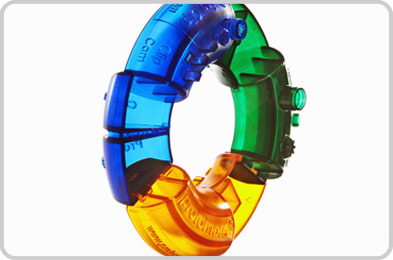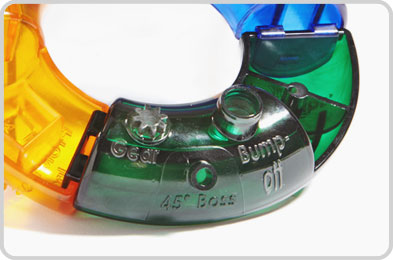 |
| September 23, 2014 | Volume 10 Issue 36 |
Designfax weekly eMagazine
Archives
Partners
Manufacturing Center
Product Spotlight
Modern Applications News
Metalworking Ideas For
Today's Job Shops
Tooling and Production
Strategies for large
metalworking plants
Conquering Complexities:
Mold-making techniques make complicated features possible
By Gus Breiland, Customer Service Engineer Manager, Proto Labs
Designing an injection-molded part with the proper draft, wall thicknesses, radii and other considerations can be complicated in itself, so when unique features like bayonets and gears are integrated into your geometry, another layer of complexity can arise. If your part requires intricate features, we're often able to manufacture them through the use of side-actions, sliding shutoffs, pickouts, and other molding methods. Here are some of the more commonly found complex features, and how they're achieved.
Bayonet mounts
Our capabilities allow for internal bayonet features in part design, which are created using relief holes and a sliding shutoff. The shutoff forms an internal through-hole in a part by bringing the A-side and B-side in contact, preventing the flow of resin into the through-hole. Protomold requires at least 3 degrees of draft on bayonets.
O-ring grooves and mushroom studs
If you design a bayonet that contains an O-ring groove, Protomold will use a two-piece pickout. A pickout is a detachable part of the mold that is manually inserted into the mold prior to the injection process and manually removed from the part after ejection (before the next cycle begins). An O-ring feature can also be made using two side-actions depending on its orientation, proximity to the parting line, and freedom from interference from other features. Additionally, we support geometries that contain mushroom studs; those features are achieved similarly to O-rings, with a two-piece pickout or two side-actions. Note that with two-piece pickouts, there will be a witness line where they come together.

Within the blue section of the Protomold Torus design example tool, various clips and bayonets are illustrated.
Text on parts
Text on parts is used for different reasons, and if your design requires it, we typically recommend that it be raised above the part versus recessed into it; recessed text on parts is not only difficult to read, but raised letters in a mold make it difficult to achieve a good finish. It gets a bit more complicated depending on the location of the text on your part. Text extruded parallel with the mold's open and close direction requires only a simple straight-pull mold to create the feature, but text extruded parallel to the parting line creates undercuts that require a side-action. A cam-operated side-action is used on the part's mold because it operates automatically during the molding process, which saves you production dollars in the end.
You can also design text on ribs. Instead of milling a long, thin rib, then milling even down further to machine the tiny text, we use one of two options. A very small end mill (0.020 in.) is used to first machine the text, then two bolted inserts create the rib afterward. The second option is electrical discharge machining (EDM), where a rapid series of electric sparks burn the desired text into the part. Both solutions will add cost to the mold. Finally, remember to apply draft to your text to facilitate easy release of the part from the mold.
Clips
Spring clips can be created in different ways, each with pros and cons. If a relief hole at the base of the clip and additional draft are acceptable, Protomold can use a sliding shutoff to create an equally functional, yet less expensive clip. If a relief hole compromises your design, a side-action can be used to mold the clip, but it must be positioned to provide access from the outer parting line. A pickout is the most costly method to create the undercut in the clip, but it can overcome nearly every shape and positioning restriction. Material is also an important consideration in regard to clip functionality. The more rigid a material is, the harder it is to release a clip, so softer materials are used more for removable connections that see repetitive use.

A gear and 45-degree boss show how Protomold incorporates complex features into your part.
Gears
A gear that is aligned parallel to the mold's open and close direction is created with a simple straight-pull mold, but if the gear is deep, the faces on the gear teeth may need to be drafted to allow the gear to eject from the mold. Furthermore, if the tooth profile is very sharp or the teeth are small, an EDM electrode, in place of milling, may be required to form the gear.
Bosses
Bosses are essentially raised stud features used to engage fasteners or support features of other parts passing through them. Most bosses are relatively easy to mold; the challenge comes when they are placed on angled surfaces or are very tall and thin. An angled boss is neither parallel to the mold open/close direction nor the parting line, which forms an undercut that is resolved with a pickout. If you have bosses that are tall and thin with a very high aspect ratio, Protomold may use a steel core pin to ensure the pin doesn't break during the molding process.
Protomold has grown in capabilities over the years. Upload a model that you think may not be moldable, and let us surprise you. Our automated quoting system will provide moldability analysis, and our stable of Customer Service Engineers is available at 877.479.3680 to discuss complex features, or any other design questions you might have. To help you further visualize and design these features, we created the Protomold Torus. It's a physical design aid that illustrates some of the complex features that your part may require. Get a free Torus here.
Published September 2014
Rate this article
View our terms of use and privacy policy
